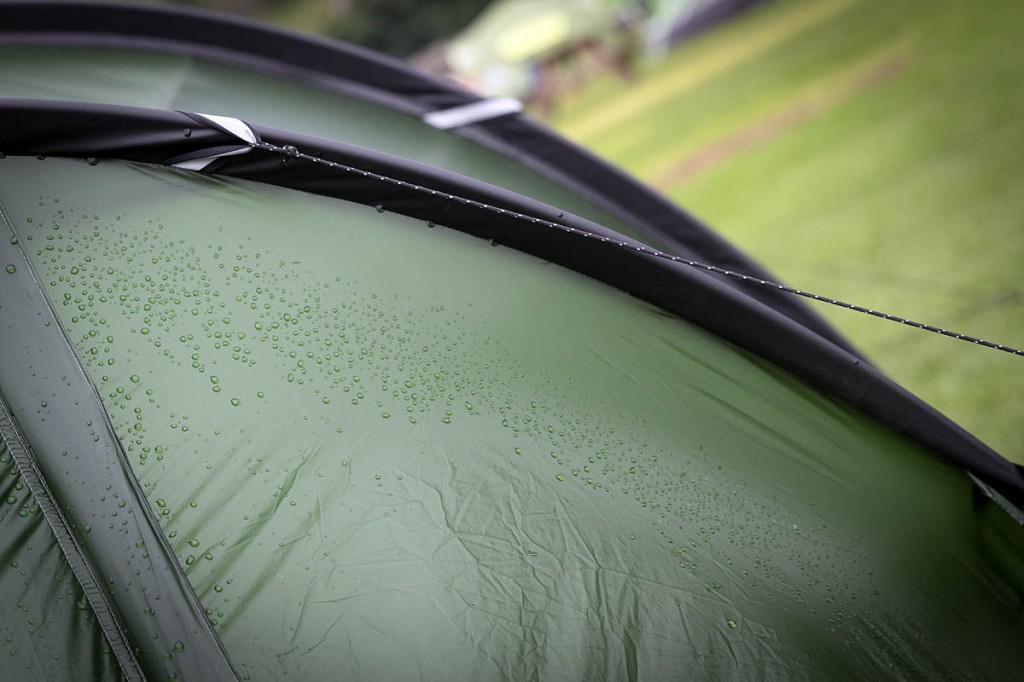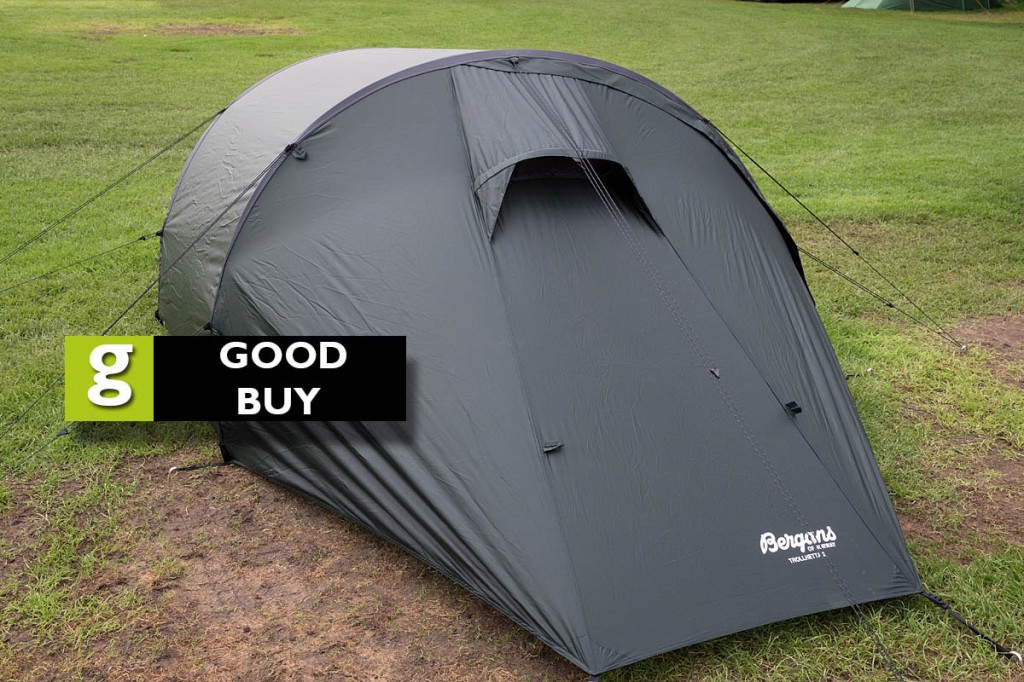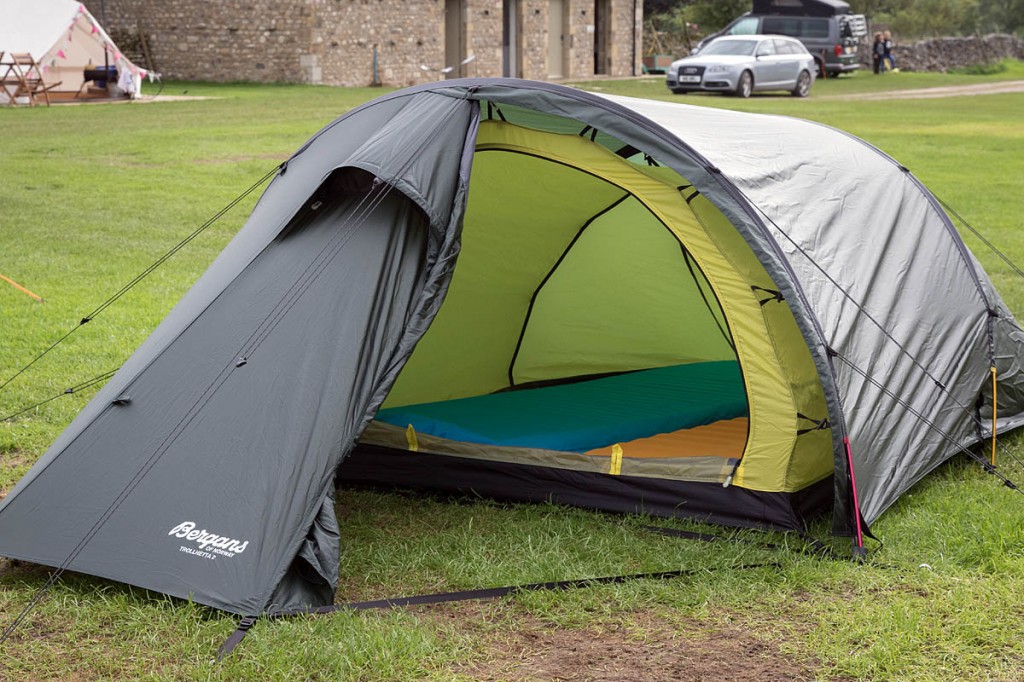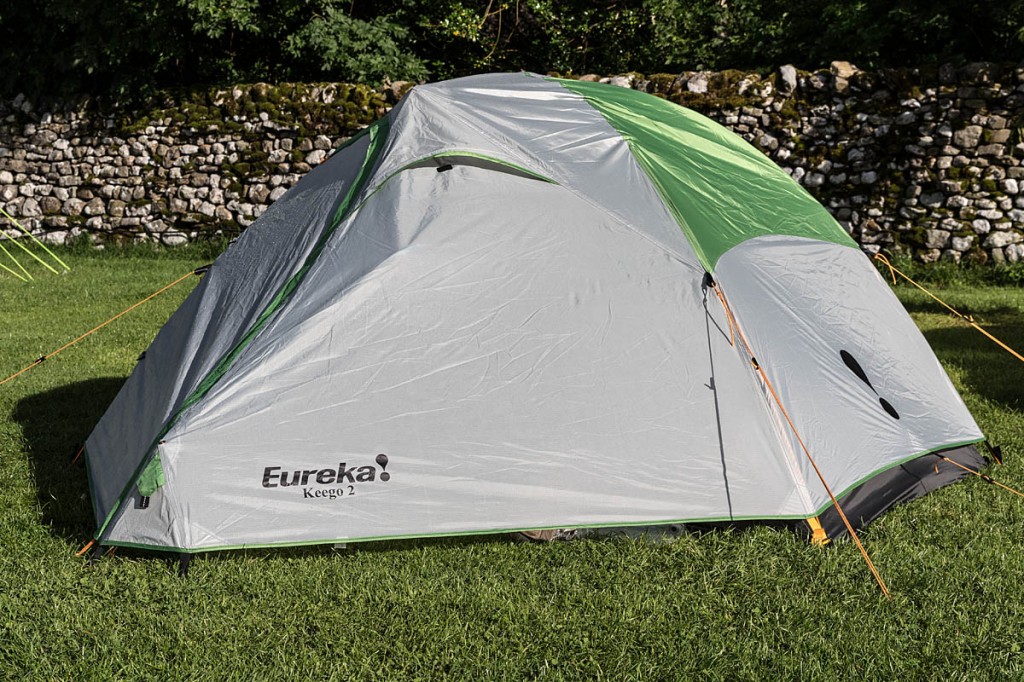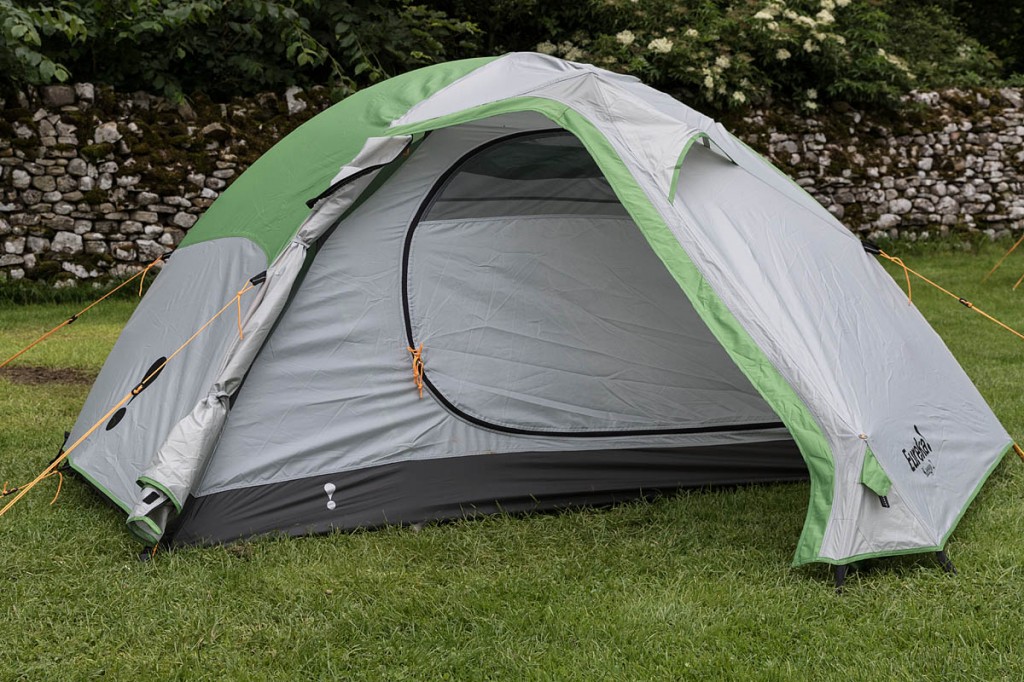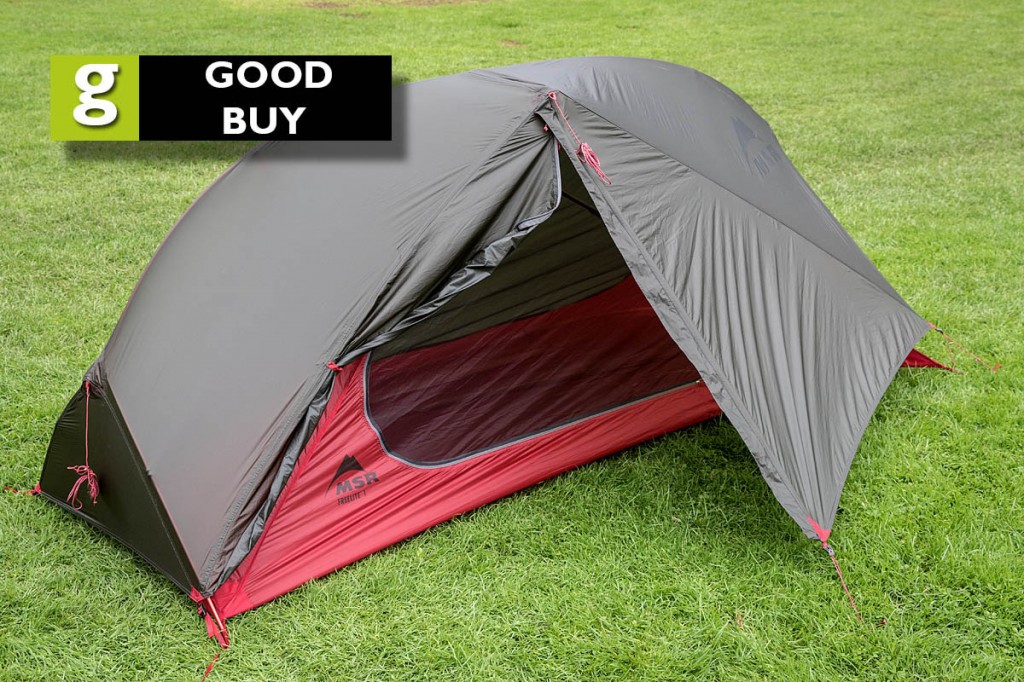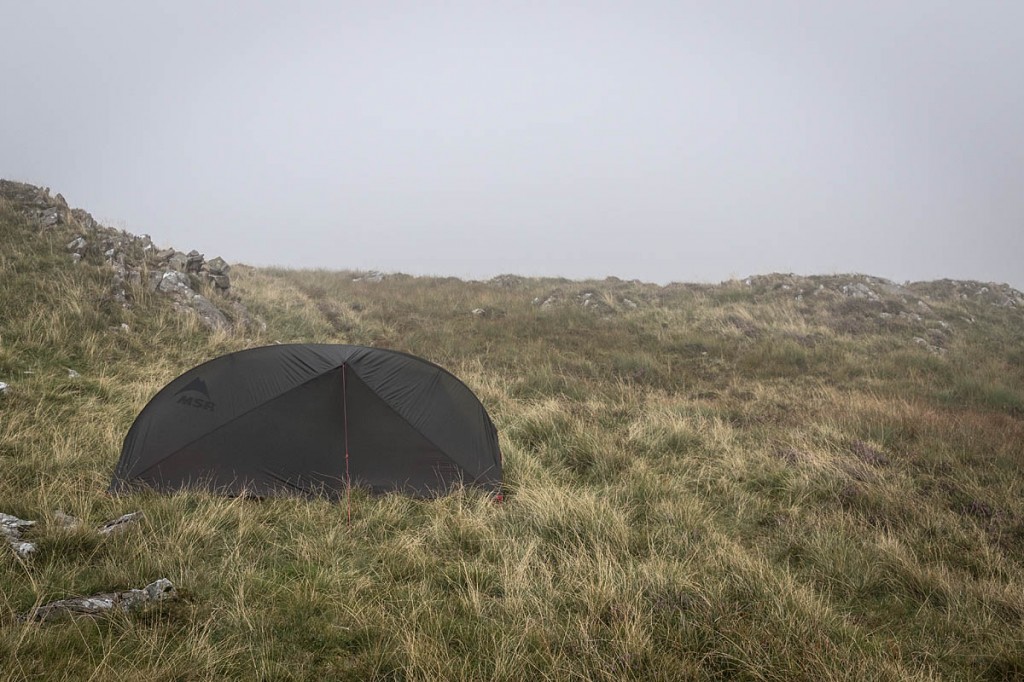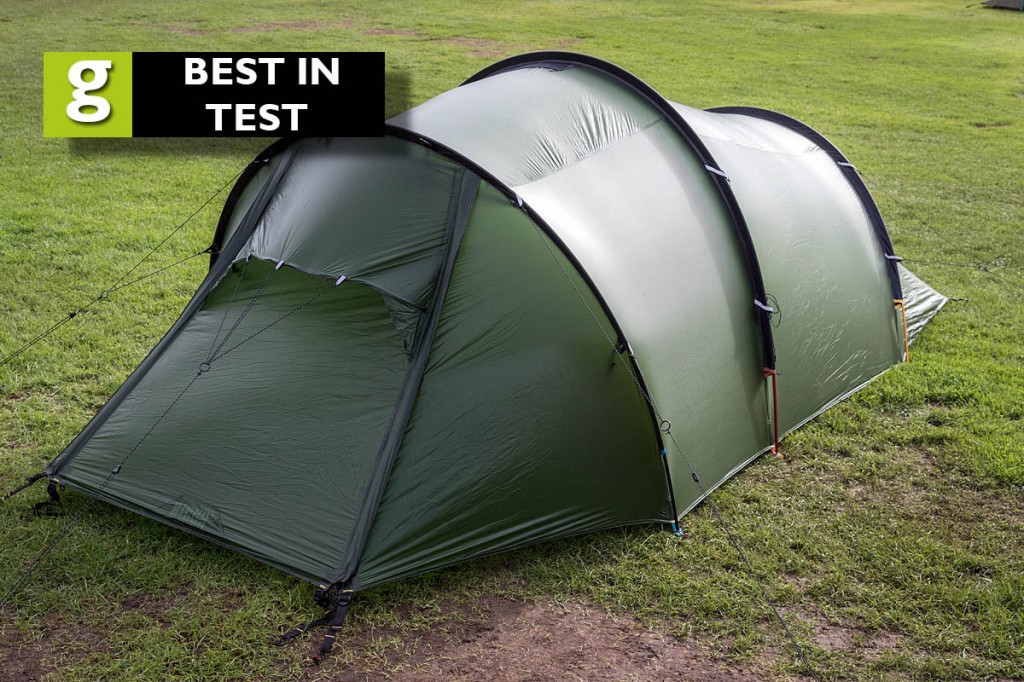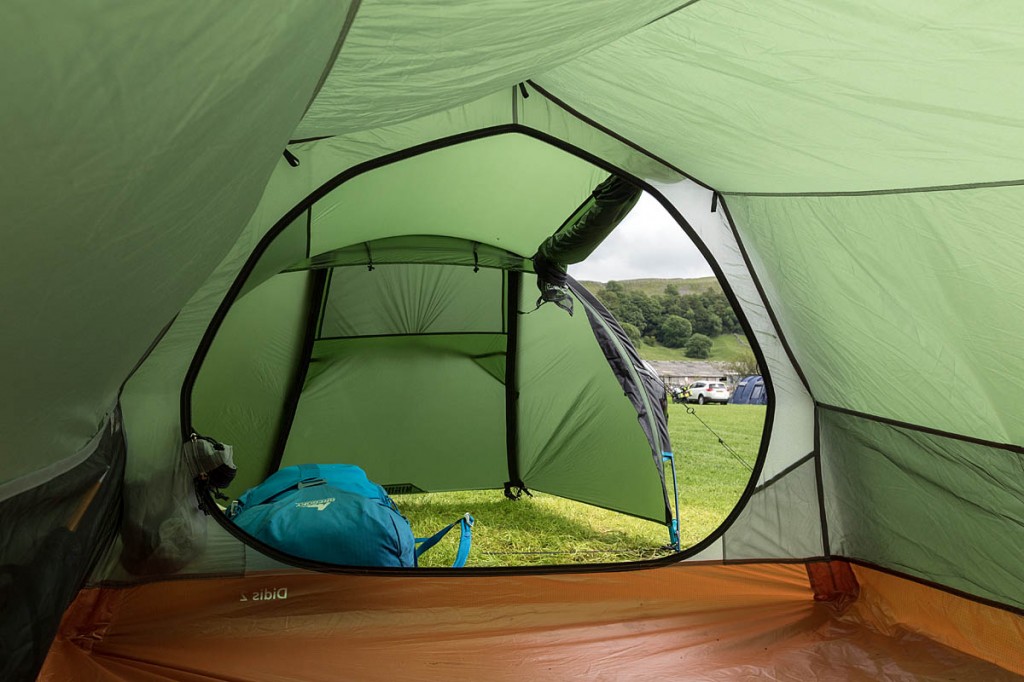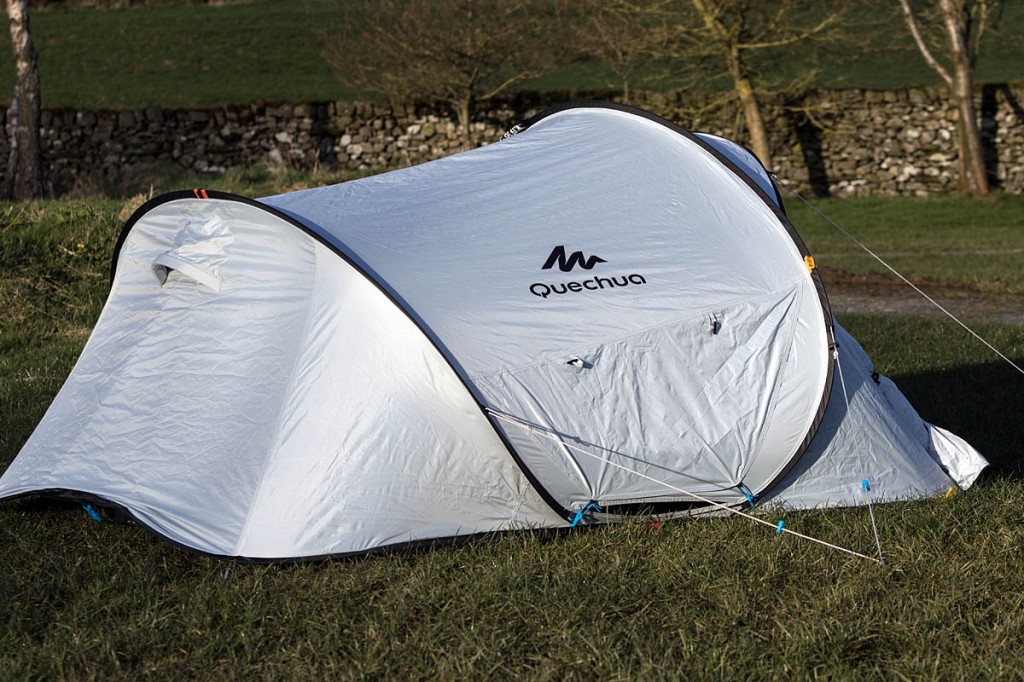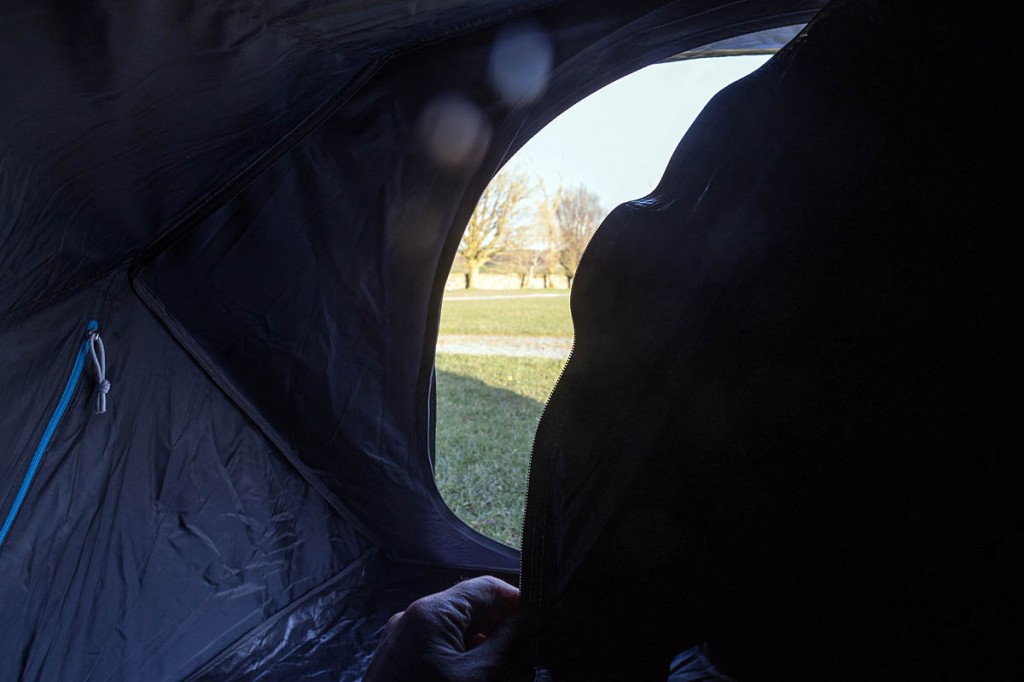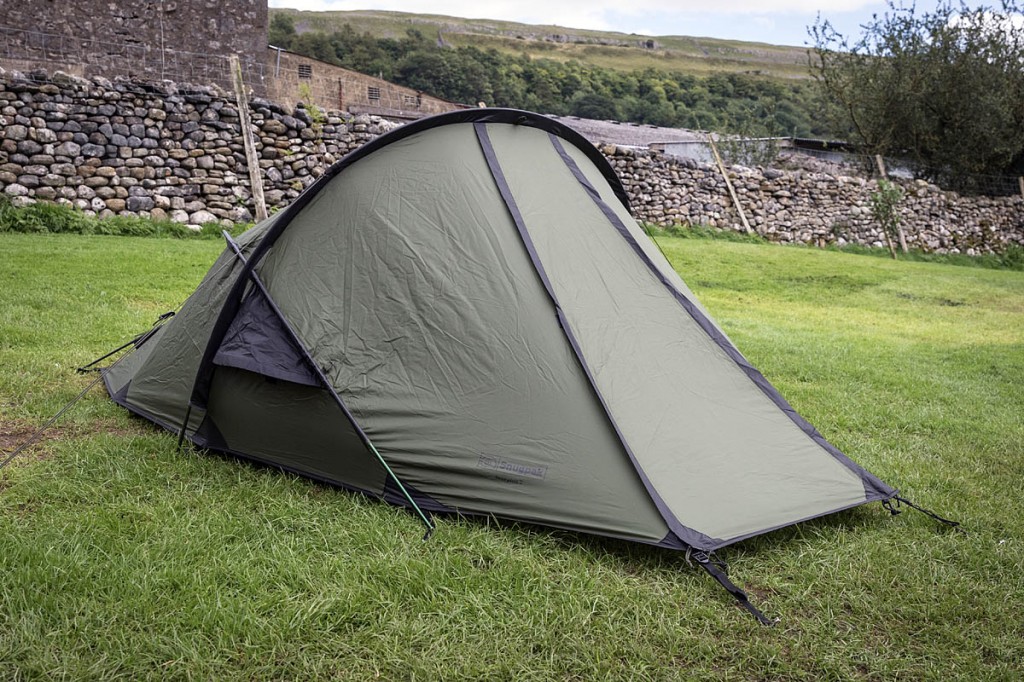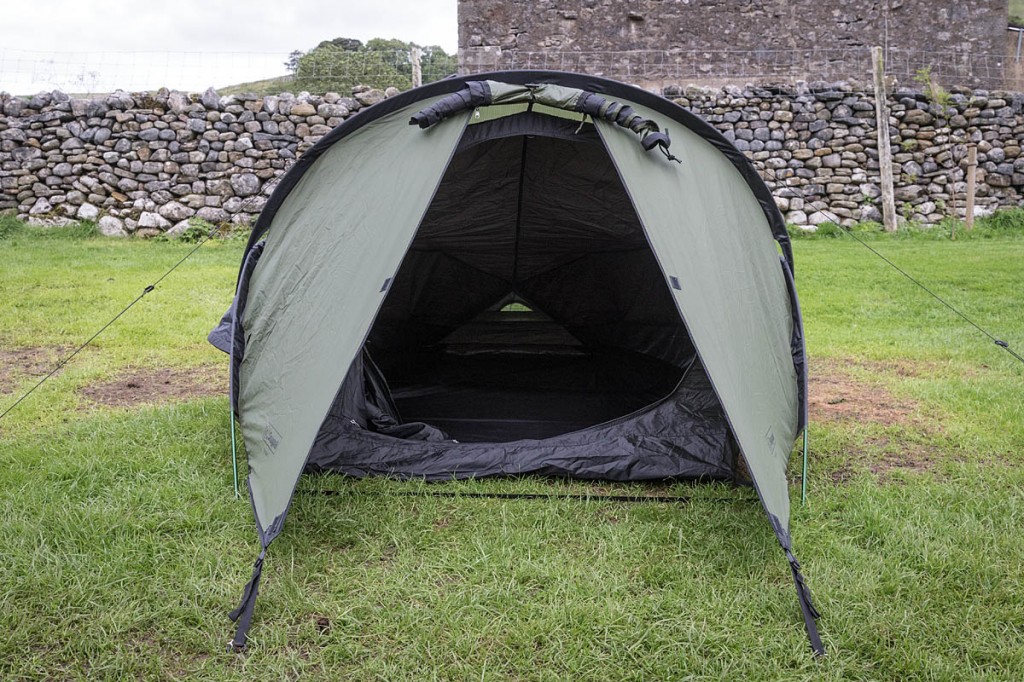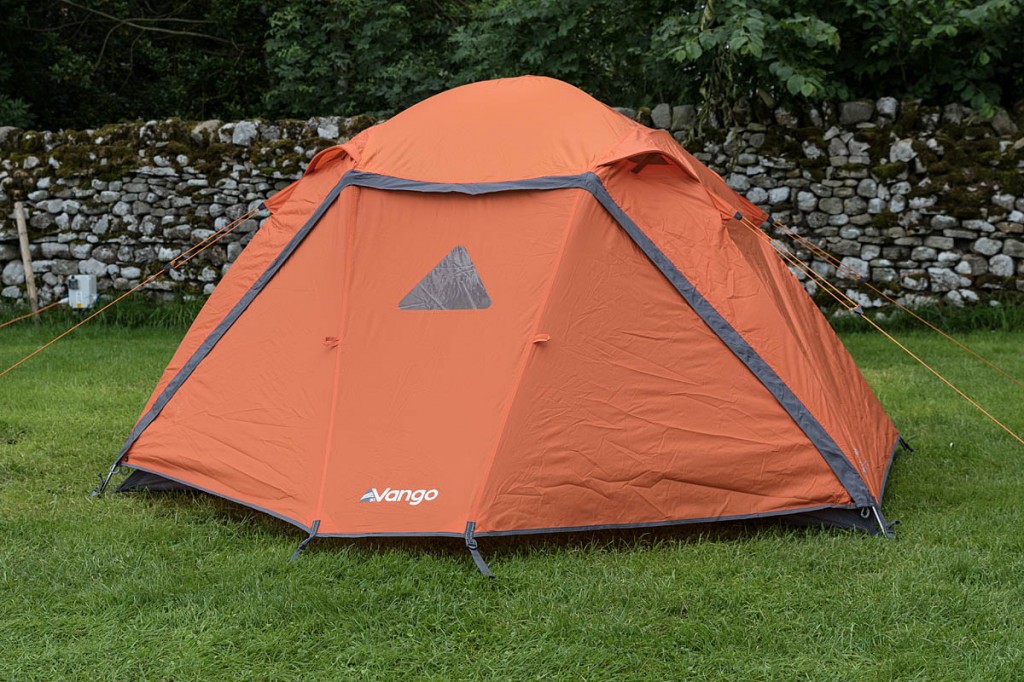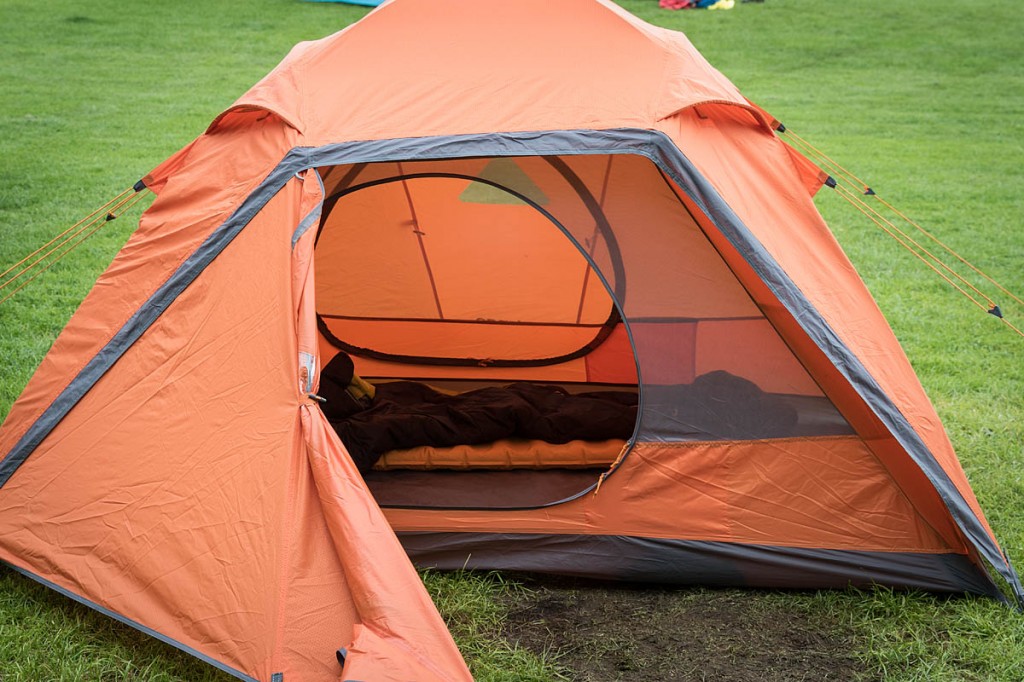Camping is one of our favourite ways of enjoying the great outdoors.
Sleeping in a tent and waking to a beautiful countryside or mountain scene is unbeatable for getting back to nature, especially if the weather’s kind.
But you also need a tent that’s going to protect you from the elements and hopefully provide you with comfortable shelter when things turn more unsettled.
If you’re backpacking on a multi-day trip, weight and size of the tent will be a big factor in your choice. If you’re camping out of the boot of a car, this is likely to be less important and space and comfort might be prime concern.
We tested seven lightweight tents, big enough for two people or, in one case, just one person.
We’ve rated them for weight, size and how well they performed in varied conditions. These are not full-on family tents, but small models, most of which pack away into a bag small compact to slip into your backpacking rucksack.
Some of them are set up by pitching the inner tent first, then placing the flysheet over this; others, you erect the fly first then the inner. This can be useful if you’re putting up the tent in rain. Some tents are pitched all-in-one, with fly and inner going up together, also a good bet in rain.
Most of the tents have aluminium poles, which tend to be more durable than cheaper glass fibre ones.
They range from a budget pop-up model to high-end high-tech tents with a price tag to match.
Bergans of Norway Trollhetta Two-Person
Price: £330
Weight: 2,578g
Colour: dark green
Packed size: 48cm x 18cm diameter
Material: nylon ripstop
Poles: aluminium
Country of manufacture: China
The Trollhetta is a tunnel tent that pitches all-in-one.
There’s a vestibule and door at one end only – the other end is used as a foot extension. The porch is a good size and the single outer door is retained in its open position by a toggle and loop.
Two colour-coded poles slide into sleeves and fix into sturdy plastic sockets which are then tensioned with straps.
There’s a tensioning strap at ground level in the vestibule to help stability. The Trollhetta has six guy lines and came with an extra spare peg. The fly sheet has zipped, cowled vents at each end.
The inner tent is yellow ripstop fabric with a zipped mesh panel at one end to aid ventilation. The Bergans tent is quite roomy and had just enough headroom for the tester (5ft 8in – 1.73m) to sit up.
We had no trouble fitting in a full-width sleep mat and a slim version. Inner tent length was good.
The inner has two mesh pockets and the inner door has mosquito netting and can be rolled back at the bottom into toggle retainers. The door can be left partly unzipped at the top for extra ventilation.
The fly, which is silicone-coated ripstop nylon, has a waterproofing rating of 3,000mm and the groundsheet 5,000mm. The tent kept us dry during testing but, with the fly door open, there was the chance of an odd drop of rain entering the inner as there’s only the fly’s zip storm flap to deter drips.
The Trollhetta was quite a warm tent. Lots of good guy lines made this tent stable in wind. It comes with a pole repair tube.
The porch is a good size and easily accommodated two rucksacks.
Pack size was small for a two-person tent, helped by compression storage bag, and weight was good too around the 2.5kg mark. For two people backpacking the Bergans Trollhetta is a good bet, especially if the weight can be shared in two rucksacks. It’s even one to consider for a solo person who values the extra space, as long as you’re prepared to carry the weight and have space for the packed tent.
Performance 15/20
Stability 15/20
Room 7/10
Ease of pitching/striking 7/10
Weight 15/20
Quality 8/10
Value for money 7/10
Total score: 74/100
Eureka KeeGo 2
Price: £149
Weight: 2,832g
Colour: grey/green
Packed size: 53cm x 23cm diameter
Material: fly, polyester ripstop; inner nylon
Poles: aluminium
Country of manufacture: China
The KeeGo 2 is a dome tent design that pitches inner first.
The inner tent is laid out and the two main poles are inserted into eyelets at each corner. The tent is then attached to the poles by means of its plastic clips. The apex of the inner tent is secured to the cross-over point of the poles by a toggle loop.
The fly is then placed over the inner and a shorter pole is inserted into a slot at the top of the sheet and a corresponding Velcro holder on the other side, which is a little fiddly to achieve. This short, ‘floating’ pole has the function of extending the fly outwards a little at its centre, away from the inner. Velcro-fastening loops are then used to secure the fly to the main poles and finally each corner is attached using the fitted plastic clips, at which point it can be pegged into place.
The side porch is then pegged out using two webbing straps. A short, captive pole extends the porch bottom upwards.
The fly’s ripstop fabric feels quite sturdy and this is borne out in the tent’s weight, which is pushing towards the 3kg mark.
A vent in the porch flank can be held open via a captive short pole, secured by Velcro. Ventilation of the inner is good, with a lot of mesh panels.
The KeeGo 2 comes with three short guys that attach to webbing loops on the bottom of three sides of the tent, and with four long guy lines to attach to sturdy webbing loops. This gave good stability in stiff breezes.
The Eureka tent is a little snug on room, and two occupants just fit in on inflatable mattresses, though the tent has good length. The porch is fairly small and will just about accommodate two rucksacks.
The inner has a single side opening, with a mesh section at the top of the zipped door. Headroom was good, and it was just possible for the tester to kneel in the KeeGo 2.
The polyurethane-coated fly is rated at 3,000mm for waterproofing, and the similarly coated ground sheet at 5,000mm. We encountered no problems keeping the water out. The porch has enough overhang to stop rain dripping into the tent when open.
Reaching for the zip at the bottom of the outer door is quite a stretch when opening up the tent in the morning.
The inner has two small pockets and the tent comes with a little cargo net that attaches to the inside of the roof, which provides a little extra storage at the cost of losing a bit of headroom.
The Eureka tent comes with repair patches and pole repair tube.
The packed tent is about average size for the class, and comes in a good compressible storage bag.
The Eureka KeeGo 2 is a reasonably priced, sturdy-feeling tent though it’s a little on the heavy and bulky side to make an ideal backpacking tent, and has only average sleeping space and porch capacity.
Rather, it makes a good, no-frills base camp tent at a good price.
Performance 14/20
Stability 13/20
Room 6/10
Ease of pitching/striking 6/10
Weight 13/20
Quality 7/10
Value for money 8/10
Total 67/100
MSR Freelite 1
Price: £310
Weight: 1,078g
Colour: grey/red
Packed size: 48cm x 15cm diameter
Material: fly, ripstop nylon; inner mesh, polyester
Poles: aluminium
Country of manufacture: China
The MSR tent is an ultra-lightweight, one-person tent where design is aimed at keeping weight and pack size down.
The Freelite 1 pitches inner first, with the corners pegged before the single, bifurcated pole is inserted into the three grommets. The inner tent is then suspended from the pole using its plastic clips. A short, floating mid-ridge pole is then inserted into its eyelets.
The fly then goes over and is tensioned using metal loops fixed on to the base of the poles at one end and cords with tensioners at the other. A Velcro loop wraps round the pole to help keep the fly in place.
The MSR tent comes with four guy lines which need to be pegged out to give stability.
The inner tent is fairly narrow, but has good length. It has a nylon lower section and mesh uppers. There is one door on the side, which can be rolled back and secured with a toggle and loop.
Headroom was good, enabling easy sitting up within the inner. There are loops to hang a lamp or drying line, and a mesh pocket at one end.
The vestibule is a reasonable size for a lightweight tent of this nature. The double zip on the fly door enables some venting by partially opening it.
Quality throughout is good and the tent has a sturdy feel despite its low weight. It comes with a pole repair tube.
The fly is a polyurethane and silicone treated ripstop nylon with a 1,200mm rating. The groundsheet has a similar rating.
We took the Freelite 1 to its natural environment: the mountains. In some very high winds and sustained rain, it did the job of protecting its inhabitant. In some very strong gusts, the tent moved about quite a bit, but kept its integrity and its ultralight fabric took the punishment.
Component quality was very good and the small pack size and low weight makes this the tent of choice for backpackers heading for the hills.
If you want to use all the guy lines, you’ll have to supply a couple of extra pegs yourself.
Performance 17/20
Stability 15/20
Room 6/10
Ease of pitching/striking 7/10
Weight 19/20
Quality 9/10
Value for money 7/10
Total 80/100
Nigor Didis 2
Price: £629
Weight: 2,540g
Colour: green
Packed size: 54cm x 26cm diameter
Material: fly, silicone-treated nylon; inner, ripstop nylon
Poles: aluminium
Country of manufacture: China
The Didis 2 is a tunnel tent whose fly is made from gossamer-like GorLyn 10 fabric, a 10 denier high tenacity nylon, ultra-thin but with a high tensile strength.
This, along with the use of NFL 8.7mm DAC aluminium poles helps keep the weight of this very roomy two-person tent around the 2.5kg mark.
The inner is thicker 15 denier ripstop nylon and the whole tent felt quite warm, though there is good ventilation to be had by unzipping the inner door to its mosquito net layer. The outer door also has a net layer so in warm weather you can maintain a view while keeping out the flying beasties. The inner has a mesh upper panel at the foot end. The fly has two cowled vents, which both have wired edges for adjustment. The fly has a waterproofing rating of 3,000mm which kept out the rain during our use.
The tent floor is 40 denier ripstop nylon with TPU coating giving 10,000mm of waterproofing.
Pitching was fairly easy. Three colour-coded poles go through the appropriate sleeves and slotted into grommets. The foot and porch extensions are pegged out, and the pole holders pegged into place. There are webbing strap adjusters to get the tension right at pegging points.
The Didis 2 has three bifurcated guy lines down each side and a trifurcated guy at each end. This makes for a very stable tent when the wind whips up. All guys have reflective areas and the tent glows nicely in the beam of a headtorch.
The porch is very big for this class of tent and is big enough to accommodate someone sitting in a small camp chair. There’s lots of space for storing two large rucksacks plus other gear. Entrance to the porch is either via a side door or, if you want extra protection for the inner from rain, through the front opening.
The inner tent is equally roomy, with enough width to fit two full-width mats. Six-footers will have no problem with the length of the inner either. There’s lots of mesh pocket space. We had no problems with condensation in the inner tent.
There was just enough height to sit up in the centre of the inner tent.
So what do you get for what is, admittedly, a fairly eye-watering price? Quality of materials and components throughout was very good. Nigor has also kept an eye on green issues, with eco-friendly anodising of the aluminium poles and pegs.
The high-tech fabrics offer low weight yet high strength and the design is well thought-out, even to little touches such as a mesh pocket that enables easy stashing of the unzipped inner tent door. For two people, there is plenty of room, something that can’t always be said of two-person-rated tents. For one person occupying the Didis 2, this verges on luxury.
Nigor rates this as a three-season tent and it performed very well in a variety of weather. You might even push it to less severe winter days.
At the end of our testing, we chose one tent to spend the final night in. And the Didis 2 was the one we chose, with little hesitation.
Performance 18/20
Stability 18/20
Room 9/10
Ease of pitching/striking 8/10
Weight 15/20
Quality 9/10
Value for money 5/10
Total 82/100
Quechua 2 Seconds 2 Fresh and Black
Price: £59.99
Weight: 3,256g
Colour: white
Packed size: 68cm x 18cm
Material: fly, polyester; inner, polyester
Poles: glass fibre
Country of manufacture: China
Quechua is one of the brands of French outdoors retail giant Decathlon, and a visit to any campsite in France will demonstrate the popularity of the brand within its home market.
The 2 Seconds 2 Fresh and Black is a development of the brand’s existing pop-up tent for two people. The fresh element is the generous amount of ventilation that can be accessed, while the black refers to the model’s innovation of having a black inner that keeps out unwanted early-morning light that might otherwise wake you.
The tent comes in a circular pack that would be an interesting prospect to try to fit into a rucksack, at 68cm diameter, so is definitely aimed at the out-of-car camper rather than the backpacker.
Pitching is a fairly simple affair: the tent is taken out of the bag, a retaining clipped band is unfastened and the tent expands to about double the size. Unclip two further bands and the tent pops out to its full form. Peg out the rear and front corners, the side guys and the two front ones and the tent is ready to use.
There’s a reasonable amount of room and we managed to squeeze in a full-with mat and a slimline one, though six-footers will take up the full length of the inner.
Ventilation comes from a large net section at the rear of the inner. Unzipping the panel at the foot of the fly enables this to be pulled up to allow a good flow of air. There are also side vents and panels which can be clipped on to the side guys to give even more air through the tent. The upper section of the inner’s door also has a mesh section.
The designers clearly had a warm Mediterranean climate in mind when building in so many ventilation possibilities. Unfortunately, our testing was confined to northern England.
The tent kept out the rain and was reasonably stable in wind, and Quechua say the 2 Seconds 2 Fresh and Black is good for use in winds up to about 30mph.
A drawback, however, is that its lack of a porch – it only has a fairly shallow cowl over the door – means in wet weather rain drips into the open tent or, after a shower, from the fly.
There’s also nowhere to stow gear; you might just squeeze a pair of boots into the space between fly and inner, so it’s definitely a tent to use when your car boot is close-by.
There are net pockets for storing small items inside the tent and there’s a lamp hook too.
The tent is certainly very dark when the door is closed and in the height of summer you can be fairly sure of not being awoken at 4am by sunlight hitting the campsite. Though you might still need earplugs to block out the dawn chorus.
Striking the tent is a little trickier than pitching it. You unpeg it, then go into the tent and grasp a loop and pull it out with you. This will partly collapse the tent, allowing two sets of plastic buckles to be fastened. This creates a double-diameter circle. You then pull a strap taut which pinches the tent in the centre of the circle, enabling the whole thing to be folded together into a circle shape that fits the bag. Brutality is the key, we found.
The Quechua 2 Seconds 2 Fresh and Black is an easy-to-pitch simple tent aimed squarely at car campers. Festival-goers too will appreciate the ease of use and the fact you can enjoy a lie-in in relative darkness. The tent provides the customary value for money from a Decathlon brand at a price that’s very competitive.
Performance 12/20
Stability 12/20
Room 6/10
Ease of pitching/striking 9/10
Weight 12/20
Quality 7/10
Value for money 9/10
Total 67/100
Snugpak Scorpion 2
Price: £249.95
Weight: 2,604g
Colour: green
Packed size: 46cm x 22cm diameter
Material: fly, polyester; inner polyester
Poles: aluminium
Country of manufacture: China
The Scorpion 2 is a sturdy-feeling ‘opposing pole’ design that pitches fly first. You then suspend the inner from it using toggles and loops, though we found, once you’ve done that, you can pack it away all together and from then on erect it all-in-one.
It has a single front door to its porch and the fly is tough-feeling polyurethane coated ripstop polyester. Waterproofing rating is 5,000mm. With the tent guyed fully, it was very stable.
Pitching the tent, especially if you’re doing it all-in-one style, is simple: slot two longer poles and one shorter one into colour-coded sleeves, press the ends into their grommets and then peg it out. The inner attaches to the pole bases via plastic buckles.
The Scorpion 2 has three vents, two at the head end of the tent on its flanks, and the other at the foot end. These are protected by substantial cowls on the fly, which can be closed using Velcro fittings.
The inner tent is quite dark fabric, which helps cut down dawn light intrusion.
The inner tent is not over-long: just enough length for a standard sleep mat. Width is also restricted. We could only fit two narrower-style sleep mats in. The inner tent slopes markedly at the foot end, so a six-footer might find their feet pressing up against the fabric if sleeping on his or her back.
Storage space inside the tent for small items is generous, with mesh pockets running the length of each side of the inner, but the porch isn’t over large, with just enough room for two rucksacks if you stack them on top of each other. The vestibule also slopes back just far enough to let rain drip into the inner when the door’s open.
There’s just enough headroom to sit up in the centre of the tent at the door end.
The Snugpak tent felt quite warm and overall its quality felt good, with strong components and pegs. It also came with a comprehensive repair kit.
The Scorpion 2 is a robust two-person tent at a reasonable price, though space is a little tight.
Performance 14/20
Stability 15/20
Room 6/10
Ease of pitching/striking 7/10
Weight 15/20
Quality 7/10
Value for money 8/10
Total 72/100
Vango Mistral 200
Price: £180
Weight: 3,052g
Colour: orange
Packed size: 49cm x 25cm diameter
Material: fly, polyester; inner, water-resistant micromesh
Poles: aluminium
Country of manufacture: China
The Mistral 200 is part of Vango’s Solis range of trekking tents, designed with warmer climes in mind.
The fly is robust-feeling Protex 70 denier polyester and has a 5,000mm waterproof rating. The inner tent uses mainly mesh to provide very good ventilation.
The Vango tent is a dome design, and was fairly easy to pitch. The inner goes up first: two main poles slot into grommets at each of the four corners, then the tent is suspended from the poles by plastic clips. Once this is done and the tent is in the required position, the four corners are pegged out.
There are two short ‘floating’ poles that go through short sleeves and attach to grommets. These proved extra space in the inner tent.
The fly then goes over and clips to each main pole foot via a plastic buckle. The twin porches are then pegged out. Space in the inner is moderate, and with two people occupying the Mistral 200 things were snug. The double porches do provide space for two rucksacks and little extra gear though.
The fly has on each side a small triangular window so you can do a quick weather check without opening the flap. The doors can be opened either side or, in warm weather, rolled up completely. There’s just about enough overhang to keep rain drips out of the inner when the doors are open.
The fly has cowled mesh vents at each corner of the tent. We found the zips on the fly doors tricky to run smoothly along the angle formed where the diagonal meets the horizontal section, particularly as this is the point at which the floating poles are anchored in their grommets. Two hands and a little manoeuvring was needed to slide the puller past these points.
The inner has a lamp loop and small mesh pockets at each end and high-level pockets that can be used to put a torch in.
The tent has bright orange guy lines with reflective detail to help visibility. These gave the tent quite good stability in wind.
The poles are good quality aluminium and the Vango tent had a sturdy feel.
Vango has been making tents for 50 years and is one of the most popular brands you’ll see on UK campsites. The Mistral 200, though designed with warm nights in mind, performed well in British summer conditions. The mainly mesh inner kept things cool without feeling cold, and meant condensation wasn’t a problem.
The tent isn’t the lightest, tipping the scales at just over 3kg, and space isn’t that generous, but the price is competitive and the Mistral 200 felt robust.
Performance 15/20
Stability 13/20
Room 6/10
Ease of pitching/striking 7/10
Weight 13/20
Quality 7/10
Value for money 7/10
Total 68/100
Best in test: Nigor Didis 2
Good buy: MSR Freelite 1
Good buy: Bergans of Norway Trollhetta 2
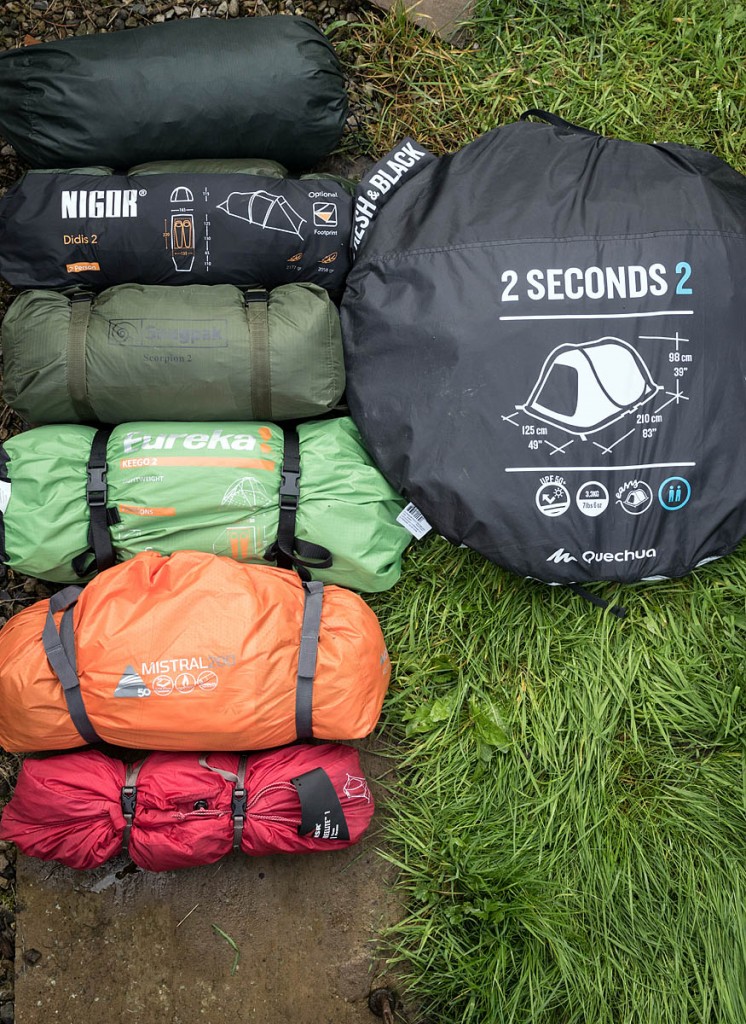
The packed tents, from top: Bergans of Norway; Nigor; Snugpak; Eureka; Vango, and MSR, with the Quechua, right
The stand-out tent was the Nigor model, with quality, space and nice design features making it our favourite of the bunch. But it is very expensive and would represent a big investment that would need lots of use to get value for money.
For a solo backpacker, the MSR tent fits the bill. It takes up little space in the rucksack and weighs very little. We were worried in the mountains that this super lightweight tent might succumb to some quite scary gusts, but it stood the test and also kept out six or seven hours of constant rain.
The Bergans of Norway tent also provided good quality at a price that wasn’t too outlandish, with a good amount of space for two occupants and a manageable weight.
- All the tents in this test were provided to grough by the brands.
